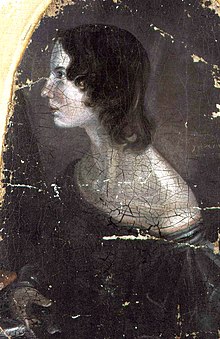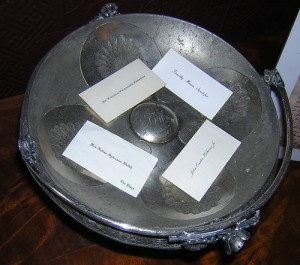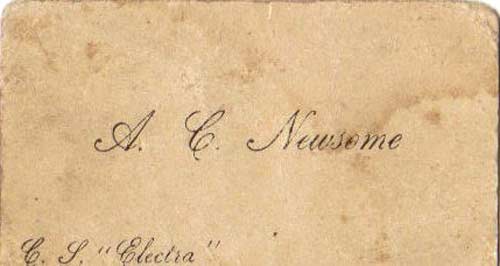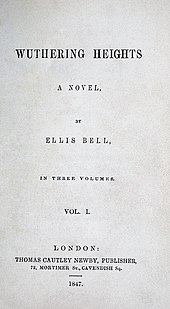
The three Brontë sisters, in an 1834 painting by their brother
Branwell Brontë. From left to right: Anne, Emily and Charlotte. (Branwell used to be between Emily and Charlotte, but subsequently painted himself out.)
After the death of their mother on 15 September 1821 from cancer, when Emily was three years old,
[5]the older sisters
Maria, Elizabeth and Charlotte were sent to the
Clergy Daughters' School at Cowan Bridge, where they encountered abuse and privations later described by Charlotte in
Jane Eyre. At the age of six on 25 November 1824, Emily joined her sisters at school for a brief period.
[6] When a
typhoidepidemic swept the school, Maria and Elizabeth caught it. Maria, who may actually have had
tuberculosis, was sent home, where she died. Emily was subsequently removed from the school, in June 1825, along with Charlotte and Elizabeth. Elizabeth died soon after their return home.
[7]
The three remaining sisters and their brother
Patrick Branwell were thereafter educated at home by their father and aunt
Elizabeth Branwell, their mother's sister. A shy girl, Emily was very close to her siblings and was known as a great animal lover, being especially noted for befriending the stray dogs she found wandering around the countryside.
[8] Despite the lack of formal education, Emily and her siblings had access to a wide range of published material; favourites included
Sir Walter Scott,
Byron,
Shelley, and
Blackwood's Magazine.
[9]
In their leisure time the children began to write fiction at home, inspired by a box of toy soldiers Branwell had received as a gift
[10] and created a number of
fantasy worlds (including 'Angria') which featured in stories they wrote – all "very strange ones" according to Charlotte
[11] – and
enacted about the imaginary adventures of their toy soldiers along with the
Duke of Wellington and his sons,
Charles and
Arthur Wellesley. Little of Emily's work from this period survives, except for poems spoken by characters.
[12][13] When Emily was 13, she and Anne withdrew from participation in the Angria story and began a new one about
Gondal, a fictional island whose myths and legends were to preoccupy the two sisters throughout their lives. With the exception of their Gondal poems and Anne's lists of Gondal's characters and place-names, the writings on Gondal were not preserved. Some "diary papers" of Emily's have survived in which she describes current events in Gondal, some of which were written, others enacted with Anne. One dates from 1841, when Emily was twenty-three: another from 1845, when she was twenty-seven.
[14] The heroes of Gondal resemble the popular image of the Highlanders of Scotland as a sort of British version of the "noble savage", being romantic outlaws who were capable of more romanticism, nobility, passion and bravery than those from "civilization". One of the fictional works produced by the Brontë siblings was Branwell's
The Life of Alexander Percy, which tells the story of how he and his wife have such a complete love and understanding for one another that eventually their love becomes self-destructive.
[16] Her brother's story was to become the inspiration for
Wuthering Heights.
[16]
At seventeen, Emily attended the Roe Head Girls' School, where Charlotte was a teacher but managed to stay only a few months before being overcome by extreme
homesickness. Charlotte later stated that: "Liberty was the breath of Emily's nostrils; without it she perished. The change from her own home to a school and from her own very noiseless, very secluded but unrestricted and unartificial mode of life, to one of disciplined routine (though under the kindest auspices), was what she failed in enduring... I felt in my heart she would die, if she did not go home, and with this conviction obtained her recall."
[17] She returned home and Anne took her place.
[18][a] At this time, the girls' objective was to obtain sufficient education to open a small school of their own.
Adulthood
Emily became a teacher at Law Hill School in
Halifax beginning in September 1838, when she was twenty.
[19] Her health broke under the stress of the 17-hour work day and she returned home in April 1839.
[20] Thereafter she became the stay-at-home daughter, doing most of the cooking, ironing, and cleaning. She taught herself German out of books and also practised the piano.
[21]
In 1842, Emily accompanied Charlotte to the Héger Pensionnat in
Brussels,
Belgium, where they attended the girls' academy run by
Constantin Héger. Unlike Charlotte, Emily felt uncomfortable in Brussels, and refused to adopt Belgian fashions, saying "I wish to be as God made me", which made her into something of an outcast.
[22] The sisters planned to perfect their French and German in anticipation of opening their school. Nine of Emily's French essays survive from this period. Héger seems to have been impressed with the strength of Emily's character, and made the following assertion:
She should have been a man – a great navigator. Her powerful reason would have deduced new spheres of discovery from the knowledge of the old; and her strong imperious will would never have been daunted by opposition or difficulty, never have given way but with life. She had a head for logic, and a capability of argument unusual in a man and rarer indeed in a woman... impairing this gift was her stubborn tenacity of will which rendered her obtuse to all reasoning where her own wishes, or her own sense of right, was concerned.
[23]
The two sisters were committed to their studies and by the end of the term had attained such competence in French that Madame Héger made a proposal for both to stay another half-year, even offering to dismiss the English master, according to Charlotte, so that she could take his place, while Emily was to teach music as she had by that time become a competent piano teacher.
[24] However, the illness and death of their aunt meant that they returned to Haworth and though they did try to open a school at their home, they were unable to attract students to the remote area.
[citation needed]
In 1844, Emily began going through all the poems she had written, recopying them neatly into two notebooks. One was labelled "Gondal Poems"; the other was unlabelled. Scholars such as Fannie Ratchford and Derek Roper have attempted to piece together a Gondal storyline and chronology from these poems.
[25][26] In the autumn of 1845, Charlotte discovered the notebooks and insisted that the poems be published. Emily, furious at the invasion of her privacy, at first refused, but relented when Anne brought out her own manuscripts and revealed to Charlotte that she had been writing poems in secret as well. As co-authors of Gondal stories, Anne and Emily were accustomed to read their Gondal stories and poems to each other, while Charlotte was excluded from their privacy.
[27] Around this time she had written one of her most famous poems "No coward soul is mine", probably as an answer to the violation of her privacy and her own transformation into a published writer.
[28] Despite Charlotte's later claim, it was not her last poem.
[29]
In 1846, the sisters' poems were published in one volume as
Poems by Currer, Ellis, and Acton Bell. The Brontë sisters had adopted pseudonyms for publication, preserving their initials: Charlotte was "Currer Bell", Emily was "Ellis Bell" and Anne was "Acton Bell".
[30] Charlotte wrote in the 'Biographical Notice of Ellis and Acton Bell' that their "ambiguous choice" was "dictated by a sort of conscientious scruple at assuming Christian names positively masculine, while we did not like to declare ourselves women, because... we had a vague impression that authoresses are liable to be looked on with prejudice".
[31] Charlotte contributed 19 poems, and Emily and Anne each contributed 21. Although the sisters were told several months after publication that only two copies had sold,
[32] they were not discouraged (of their two readers, one was impressed enough to request their autographs).
[33]The Athenaeum reviewer praised Ellis Bell's work for its music and power, singling out his poems as the best: "Ellis possesses a fine, quaint spirit and an evident power of wing that may reach heights not here attempted",
[34] and
The Critic reviewer recognised "the presence of more genius than it was supposed this utilitarian age had devoted to the loftier exercises of the intellect."
[35]
Personality and character

Disputed portrait made by
Branwell Brontë about 1833; sources are in disagreement over whether this image is of Emily or Anne.
[1]
Emily Brontë remains a mysterious figure and a challenge to biographers because information about her is sparse
[36] due to her solitary and reclusive nature.
[37] Except for
Ellen Nussey and Louise de Bassompierre, Emily's fellow student in Brussels, she does not seem to have made any friends outside her family. Her closest friend was her sister Anne. Together they shared their own fantasy world, Gondal, and, according to Ellen Nussey, in childhood they were "like twins", "inseparable companions" and "in the very closest sympathy which never had any interruption".
[38][39] In 1845 Anne took Emily to visit some of the places she had come to know and love in the five years she spent as governess. A plan to visit
Scarborough fell through and instead the sisters went to
York where Anne showed her sister
York Minster. During the trip Emily and Anne acted out some of their Gondal characters.
[40]
Charlotte Brontë remains the primary source of information about Emily, although as an elder sister, writing publicly about her shortly after her death, she is not a neutral witness.
Stevie Davies believes that there is what might be called Charlotte's smoke-screen and argues that Emily evidently shocked her, to the point where she may even have doubted her sister's sanity. After Emily's death, Charlotte rewrote her character, history and even poems on a more acceptable (to her and the bourgeois reading public) model.
[41] Charlotte presented Emily as someone whose "natural" love of the beauties of nature had become somewhat exaggerated owing to her shy nature, making her too fond of the Yorkshire moors, and causing her to become homesick whenever she was away. According to
Lucasta Miller, in her analysis of Brontë biographies, "Charlotte took on the role of Emily's first mythographer."
[43] In the
Preface to the Second Edition of
Wuthering Heights, in 1850, Charlotte wrote:
My sister's disposition was not naturally gregarious; circumstances favoured and fostered her tendency to seclusion; except to go to church or take a walk on the hills, she rarely crossed the threshold of home. Though her feeling for the people round was benevolent, intercourse with them she never sought; nor, with very few exceptions, ever experienced. And yet she knew them: knew their ways, their language, their family histories; she could hear of them with interest, and talk of them with detail, minute, graphic, and accurate; but WITH them, she rarely exchanged a word.
[44]
Emily's unsociability and extremely shy nature have subsequently been reported many times.
[45][46][47] According to Norma Crandall, her "warm, human aspect" was "usually revealed only in her love of nature and of animals".
[48] In a similar description,
Literary news (1883) states: "[Emily] loved the solemn moors, she loved all wild, free creatures and things",
[49] and critics attest that her love of the moors is manifest in
Wuthering Heights.
[50] Over the years, Emily's love of nature has been the subject of many anecdotes. A newspaper dated 31 December 1899, gives the folksy account that "with bird and beast [Emily] had the most intimate relations, and from her walks she often came with fledgling or young rabbit in hand, talking softly to it, quite sure, too, that it understood".
[51] Elizabeth Gaskell, in her biography of Charlotte, told the story of Emily's punishing her pet dog Keeper for lying "on the delicate white counterpane" that covered one of the beds in the Parsonage. According to Gaskell, she struck him with her fists till he was "half-blind" with his eyes "swelled up". This story is apocryphal,
[52][b] and contradicts the following account of Emily's and Keeper's relationship:
Poor old Keeper, Emily's faithful friend and worshipper, seemed to understand her like a human being. One evening, when the four friends were sitting closely round the fire in the sitting-room, Keeper forced himself in between Charlotte and Emily and mounted himself on Emily’s lap; finding the space too limited for his comfort he pressed himself forward on to the guest’s knees, making himself quite comfortable. Emily’s heart was won by the unresisting endurance of the visitor, little guessing that she herself, being in close contact, was the inspiring cause of submission to Keeper’s preference. Sometimes Emily would delight in showing off Keeper—make him frantic in action, and roar with the voice of a lion. It was a terrifying exhibition within the walls of an ordinary sitting-room. Keeper was a solemn mourner at Emily’s funeral and never recovered his cheerfulness.
In
Queens of Literature of the Victorian Era (1886), Eva Hope summarises Emily's character as "a peculiar mixture of timidity and Spartan-like courage", and goes on to say, "She was painfully shy, but physically she was brave to a surprising degree. She loved few persons, but those few with a passion of self-sacrificing tenderness and devotion. To other people's failings she was understanding and forgiving, but over herself she kept a continual and most austere watch, never allowing herself to deviate for one instant from what she considered her duty."
[55]
Wuthering Heights
Emily Brontë's
Wuthering Heights was first published in
London in 1847 by
Thomas Cautley Newby, appearing as the first two volumes of a three-volume set that included
Anne Brontë's
Agnes Grey. The authors were printed as being Ellis and Acton Bell; Emily's real name did not appear until 1850, when it was printed on the title page of an edited commercial edition.
[56] The novel's innovative structure somewhat puzzled critics.
Wuthering Heights's violence and passion led the Victorian public and many early reviewers to think that it had been written by a man.
[57] According to
Juliet Gardiner, "the vivid sexual passion and power of its language and imagery impressed, bewildered and appalled reviewers."
[58] Even though it received mixed reviews when it first came out, and was often condemned for its portrayal of amoral passion, the book subsequently became an English literary classic.
[59] Emily Brontë never knew the extent of fame she achieved with her only novel, as she died a year after its publication, aged 30.
Although a letter from her publisher indicates that Emily had begun to write a second novel, the manuscript has never been found. Perhaps Emily or a member of her family eventually destroyed the manuscript, if it existed, when she was prevented by illness from completing it. It has also been suggested that, though less likely, the letter could have been intended for
Anne Brontë, who was already writing
The Tenant of Wildfell Hall, her second novel.
[60]
Death
Emily's health probably was weakened by the harsh local climate and by unsanitary conditions at home,
[61] the source of water being contaminated by runoff from the church's graveyard.
[c] Branwell died suddenly, on Sunday, September 24, 1848. At his funeral service, a week later, Emily caught a severe cold which quickly developed into inflammation of the lungs and led to
tuberculosis.
[62][d] Though her condition worsened steadily, she rejected medical help and all offered remedies, saying that she would have "no poisoning doctor" near her.
[64] On the morning of 19 December 1848, Charlotte, fearing for her sister, wrote this:
She grows daily weaker. The physician's opinion was expressed too obscurely to be of use – he sent some medicine which she would not take. Moments so dark as these I have never known – I pray for God's support to us all.
[65]
At noon, Emily was worse; she could only whisper in gasps. With her last audible words she said to Charlotte, "If you will send for a doctor, I will see him now"
[66] but it was too late. She died that same day at about two in the afternoon. According to
Mary Robinson, an early biographer of Emily, it happened while she was sitting on the sofa.
[67] However, Charlotte's letter to William Smith Williams where she mentions Emily's dog, Keeper, lying at the side of her dying-bed, makes this statement seem unlikely.
[68]
It was less than three months since Branwell's death, which led Martha Brown, a housemaid, to declare that "Miss Emily died of a broken heart for love of her brother".
[69] Emily had grown so thin that her coffin measured only 16 inches wide. The carpenter said he had never made a narrower one for an adult.
[70] She was interred in the Church of
St Michael and All Angels family capsule in
Haworth.












